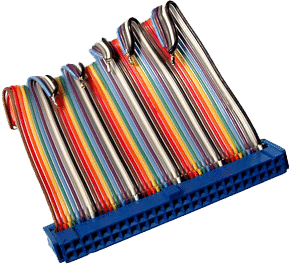Testing Adapter Resistance

The product mating connectors on adapters wear with use and as they wear the contact resistance increases. The higher resistance is included in measurements, and it will eventually cause false failures if the adapters are kept in service too long. The point at which the contact resistance becomes “too” high depends on the application. A contact resistance of 1 ohm may be acceptable if the test threshold is 10 ohms but won’t be if the threshold is 2 ohms.
Shorting Blocks
Adapters can be tested for high contact resistance using shorting blocks. A shorting block is a mating connector for the adapter that has all its pins, or groups of pins, shorted together. It can be made by soldering connections directly between pins on the connector or by shorting together wires that are terminated in the connector. The important consideration is that all pins in the block are shorted to at least one other pin.

To test adapters using a Shorting Block:
- If possible, the best starting point is to run the zero-ohm portion of the performance verification to ensure that the tester’s PV receptacles are in good condition and are providing very low resistance connections. You can find your tester’s performance check kit manual here.
- Use the self-programming feature of the tester to learn the shorting block (wires only – no components). The important learn/test parameter is the Connection Resistance threshold. Using a threshold of <1 ohm is suggested, but this can be adjusted lower or higher depending on the application requirements as noted above.
- After performing the learn, verify that every point in the shorting block is included in the test program.
- Select the Continuous test method to allow the shorting block to be wiggled while checking for intermittent errors during testing.
- Save the test program.
- Label the shorting block with the adapter part number and the test program name.
- To test an adapter, plug it into the tester in the location required by the test program. On newer testers, the 4200, 4250 and Easy-Touch, the tester prompts the user to install the appropriate adapter in the specified location.
- Load the test program and run the test. If the test fails, replace the adapter. If the test passes initially, wiggle the shorting block during intermittent testing to see if a failure condition can be induced. A pass means that the contact resistances of the connector pins are meeting the test program requirements.
Note: For older testers, the same process can be followed. However, instead of saving the test program it may be easier to save the signature of the learned shorting block. Note the learn parameters and the adapter location. To test adapters of the same type, install the adapter, learn the shorting block using the same test parameters, and compare the learned signature to the original. It should match.







